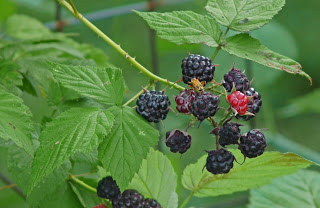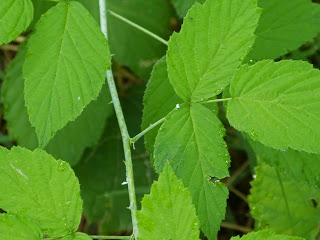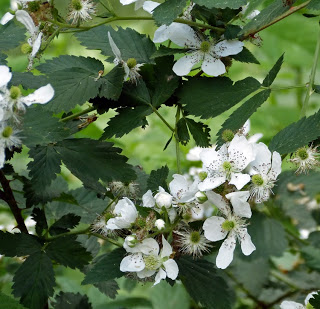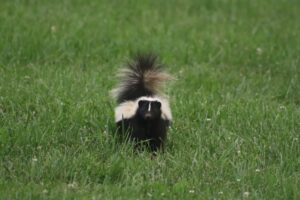The older I get, the more confused about similar things sometimes. On the other hand, there are many similar things in nature that I have always had trouble distinguishing. On a recent walk around the grounds of the Nature Preserve, I found two of those similar things growing right next to each other. Blackberry and black raspberry are two different fruits. A person who is not that exposed to berries will surely have a hard time distinguishing one from the other; but you can never blame them because it is really hard to tell which is which by simply looking at the fruit itself. Bramble fruits are characterized by the clustering of smaller fruits (druplets) to become one bigger clump of fruit.
Blackberries are perennial plants which typically bear biennial stems (“canes”) from the perennial root system. In its first year, a new stem, the primocane, grows vigorously arching or trailing along the ground and bearing large palmately compound leaves with five or seven leaflets; it does not produce any flowers. In its second year, the cane becomes a floricane and the stem does not grow longer, but the lateral buds break to produce flowering laterals (which have smaller leaves with three or five leaflets). First- and second-year shoots usually have numerous short-curved, very sharp prickles that are often erroneously called thorns. These prickles can tear through denim with ease and make the plant very difficult to navigate around. Unmanaged mature plants form a tangle of dense arching stems, the branches rooting from the node tip on many species when they reach the ground. Vigorous and growing rapidly in woods, scrub, hillsides, and hedgerows, blackberry shrubs tolerate poor soils, readily colonizing wasteland, ditches, and vacant lots. Blackberry leaves are food for certain caterpillars; some grazing mammals, especially deer, are also very fond of the leaves.
The flowers are produced in late spring and early summer on short racemes on the tips of the flowering laterals. Each flower is about 2–3 cm in diameter with five white or pale pink petals.
The drupelets only develop around ovules that are fertilized by the male gamete from a pollen grain. The most likely cause of undeveloped ovules is inadequate pollinator visits. Even a small change in conditions, such as a rainy day or a day too hot for bees to work after early morning, can reduce the number of bee visits to the flower, thus reducing the quality of the fruit. Incomplete drupelet development can also be a symptom of exhausted reserves in the plant’s roots or infection with a virus such as Raspberry bushy dwarf virus.
The black raspberry has lots of tiny prickles on the stems, and larger leaves. When you pick up the black raspberry from the plant, you will notice that it has become hollow. In other words, its stem (more appropriately termed as receptacle) was pulled out from the fruit and remained with the plant. This is not the case with blackberries because when you harvest them, you will almost always retain its stem.





